Mapping Smart Materials’ Literature: An Insight between 1990 and 2022
Abstract
:1. Introduction
2. Methodology
3. Results and Discussion
3.1. Keywords Analysis
3.2. Publications Evolution
3.3. Global Contribution and Leading Countries
3.4. Contribution of Leading Institutions
3.5. Contribution of Leading Research Areas
3.6. Leading Publishers
3.7. Contribution of Leading Authors
3.8. Leading Journals
3.9. Most Cited Articles
3.10. Most Cited Reviews
4. Conclusions
Author Contributions
Funding
Data Availability Statement
Acknowledgments
Conflicts of Interest
References
- Bogue, R. Smart materials: A review of capabilities and applications. Assem. Autom. 2014, 34, 16–22. [Google Scholar] [CrossRef]
- Takagi, T. A concept of intelligent materials and the current activities of intelligent materials in Japan. In Proceedings of the First European Conference on Smart Structures and Materials, Glasgow, UK, 12–14 May 1992; SPIE: Bellingham, WA, USA; p. 3. [Google Scholar] [CrossRef]
- Bogue, R. Smart materials: A review of recent developments. Assem. Autom. 2012, 32, 3–7. [Google Scholar] [CrossRef]
- Rusu, D.-M.; Mândru, S.-D.; Biriș, C.-M.; Petrașcu, O.-L.; Morariu, F.; Ianosi-Andreeva-Dimitrova, A. Soft Robotics: A Systematic Review and Bibliometric Analysis. Micromachines 2023, 14, 359. [Google Scholar] [CrossRef]
- Fettermann, D.C.; Cavalcante, C.G.S.; de Almeida, T.D.; Tortorella, G.L. How does Industry 4.0 contribute to operations management? J. Ind. Prod. Eng. 2018, 35, 255–268. [Google Scholar] [CrossRef]
- Addington, D.M.; Schodek, D.L. Smart Materials and New Technologies: For the Architecture and Design Professions; Architectural Press: Amsterdam, The Netherlands; Boston, MA, USA,, 2005. [Google Scholar]
- Addington, M.; Schodek, D. Smart Materials and Technologies in Architecture; Routledge: Oxfordshire, UK, 2012. [Google Scholar] [CrossRef]
- Pfenning, A. Encyclopedia of Chemical Technology, Vol. 4, 4th Edition. VonM. Howe-Grant(Ed.), John Wiley & Sons, New York 1992. 1117 S., zahlr. Abb. und Tab., £ 150.00. Chem. Ing. Tech. 1993, 65, 1381. [Google Scholar] [CrossRef]
- Bahl, S.; Nagar, H.; Singh, I.; Sehgal, S. Smart Materials Types, Properties and Applications: A Review. Mater. Today Proc. 2020, 28, 1302–1306. [Google Scholar] [CrossRef]
- Copaci, D.; Martin, F.; Moreno, L.; Blanco, D. SMA Based Elbow Exoskeleton for Rehabilitation Therapy and Patient Evaluation. IEEE Access 2019, 7, 31473–31484. [Google Scholar] [CrossRef]
- Serrano, D.; Copaci, D.-S.; Moreno, L.; Blanco, D. SMA based wrist exoskeleton for rehabilitation therapy. In Proceedings of the 2018 IEEE/RSJ International Conference on Intelligent Robots and Systems (IROS), Madrid, Spain, 1–5 October 2018; pp. 2318–2323. [Google Scholar] [CrossRef]
- Lee, J.-H.; Chung, Y.S.; Rodrigue, H. Long Shape Memory Alloy Tendon-based Soft Robotic Actuators and Implementation as a Soft Gripper. Sci. Rep. 2019, 9, 11251. [Google Scholar] [CrossRef]
- Yang, Y.; Pei, Z.; Li, Z.; Wei, Y.; Ji, Y. Making and Remaking Dynamic 3D Structures by Shining Light on Flat Liquid Crystalline Vitrimer Films without a Mold. J. Am. Chem. Soc. 2016, 138, 2118–2121. [Google Scholar] [CrossRef]
- McDonald, K.; Rendos, A.; Woodman, S.; Brown, K.A.; Ranzani, T. Magnetorheological Fluid-Based Flow Control for Soft Robots. Adv. Intell. Syst. 2020, 2, 2000139. [Google Scholar] [CrossRef]
- Silva-Muñoz, R.A.; Lopez-Anido, R.A. Structural health monitoring of marine composite structural joints using embedded fiber Bragg grating strain sensors. Compos. Struct. 2009, 89, 224–234. [Google Scholar] [CrossRef]
- Sathian, A.; Vijay, N.; Joshy, K.S.; Bharat Dalvi, Y.; Mraiche, F. Hydrogels: Smart Materials in Drug Delivery; IntechOpen: London, UK, 2022. [Google Scholar] [CrossRef]
- Youn, J.-H.; Jeong, S.M.; Hwang, G.; Kim, H.; Hyeon, K.; Park, J.; Kyung, K.-U. Dielectric Elastomer Actuator for Soft Robotics Applications and Challenges. Appl. Sci. 2020, 10, 640. [Google Scholar] [CrossRef]
- I Idumah, C. Recent advancements in self-healing polymers, polymer blends, and nanocomposites. Polym. Polym. Compos. 2021, 29, 246–258. [Google Scholar] [CrossRef]
- Kumar, E.K.; Patel, S.S.; Kumar, V.; Panda, S.K.; Mahmoud, S.R.; Balubaid, M. State of Art Review on Applications and Mechanism of Self-Healing Materials and Structure. Arch. Comput. Methods Eng. 2023, 30, 1041–1055. [Google Scholar] [CrossRef]
- Alzard, M.H.; El-Hassan, H.; El-Maaddawy, T.; Alsalami, M.; Abdulrahman, F.; Hassan, A.A. A Bibliometric Analysis of the Studies on Self-Healing Concrete Published between 1974 and 2021. Sustainability 2022, 14, 11646. [Google Scholar] [CrossRef]
- Waltman, L.; Larivière, V. The challenges of scientometric studies of predatory publishing. Quant. Sci. Stud. 2022, 3, 857–858. [Google Scholar] [CrossRef]
- Zhou, Y.; Li, H. A Scientometric Review of Soft Robotics: Intellectual Structures and Emerging Trends Analysis (2010–2021). Front. Robot. AI 2022, 9, 868682. [Google Scholar] [CrossRef] [PubMed]
- Liu, W. The data source of this study is Web of Science Core Collection? Not enough. Scientometrics 2019, 121, 1815–1824. [Google Scholar] [CrossRef]
- Bornmann, L.; Guns, R.; Thelwall, M.; Wolfram, D. Which aspects of the Open Science agenda are most relevant to scientometric research and publishing? An opinion paper. Quant. Sci. Stud. 2021, 2, 438–453. [Google Scholar] [CrossRef]
- Liu, W. Caveats for the use of Web of Science Core Collection in old literature retrieval and historical bibliometric analysis. Technol. Forecast. Soc. Chang. 2021, 172, 121023. [Google Scholar] [CrossRef]
- Xie, Q.; Meng, Q.; Yu, W.; Xu, R.; Wu, Z.; Wang, X.; Yu, H. Design of a soft bionic elbow exoskeleton based on shape memory alloy spring actuators. Mech. Sci. 2023, 14, 159–170. [Google Scholar] [CrossRef]
- Joyee, E.B.; Pan, Y. A Fully Three-Dimensional Printed Inchworm-Inspired Soft Robot with Magnetic Actuation. Soft Robot. 2019, 6, 333–345. [Google Scholar] [CrossRef]
- Tollefson, J. China declared world’s largest producer of scientific articles. Nature 2018, 553, 390. [Google Scholar] [CrossRef] [PubMed]
- Lin, W.-C.; Chang, C.-W. The influence of Chinese scholars on global research. Sci. Rep. 2022, 12, 18410. [Google Scholar] [CrossRef] [PubMed]
- Holtz, J.H.; Asher, S.A. Polymerized colloidal crystal hydrogel films as intelligent chemical sensing materials. Nature 1997, 389, 829–832. [Google Scholar] [CrossRef] [PubMed]
- Zheng, H.; Ou, J.Z.; Strano, M.S.; Kaner, R.B.; Mitchell, A.; Kalantar-Zadeh, K. Nanostructured Tungsten Oxide-Properties, Synthesis, and Applications. Adv. Funct. Mater. 2011, 21, 2175–2196. [Google Scholar] [CrossRef]
- Sagara, Y.; Kato, T. Mechanically induced luminescence changes in molecular assemblies. Nat. Chem. 2009, 1, 605–610. [Google Scholar] [CrossRef]
- Vallet-Regí, M.; Balas, F.; Arcos, D. Mesoporous Materials for Drug Delivery. Angew. Chem. Int. Ed. 2007, 46, 7548–7558. [Google Scholar] [CrossRef]
- Moniz, S.J.A.; Shevlin, S.A.; Martin, D.J.; Guo, Z.-X.; Tang, J. Visible-light driven heterojunction photocatalysts for water splitting—A critical review. Energy Environ. Sci. 2015, 8, 731–759. [Google Scholar] [CrossRef]
- Yuan, S.; Feng, L.; Wang, K.; Pang, J.; Bosch, M.; Lollar, C.; Sun, Y.; Qin, J.; Yang, X.; Zhang, P.; et al. Stable Metal–Organic Frameworks: Design, Synthesis, and Applications. Adv. Mater. 2018, 30, e1704303. [Google Scholar] [CrossRef]
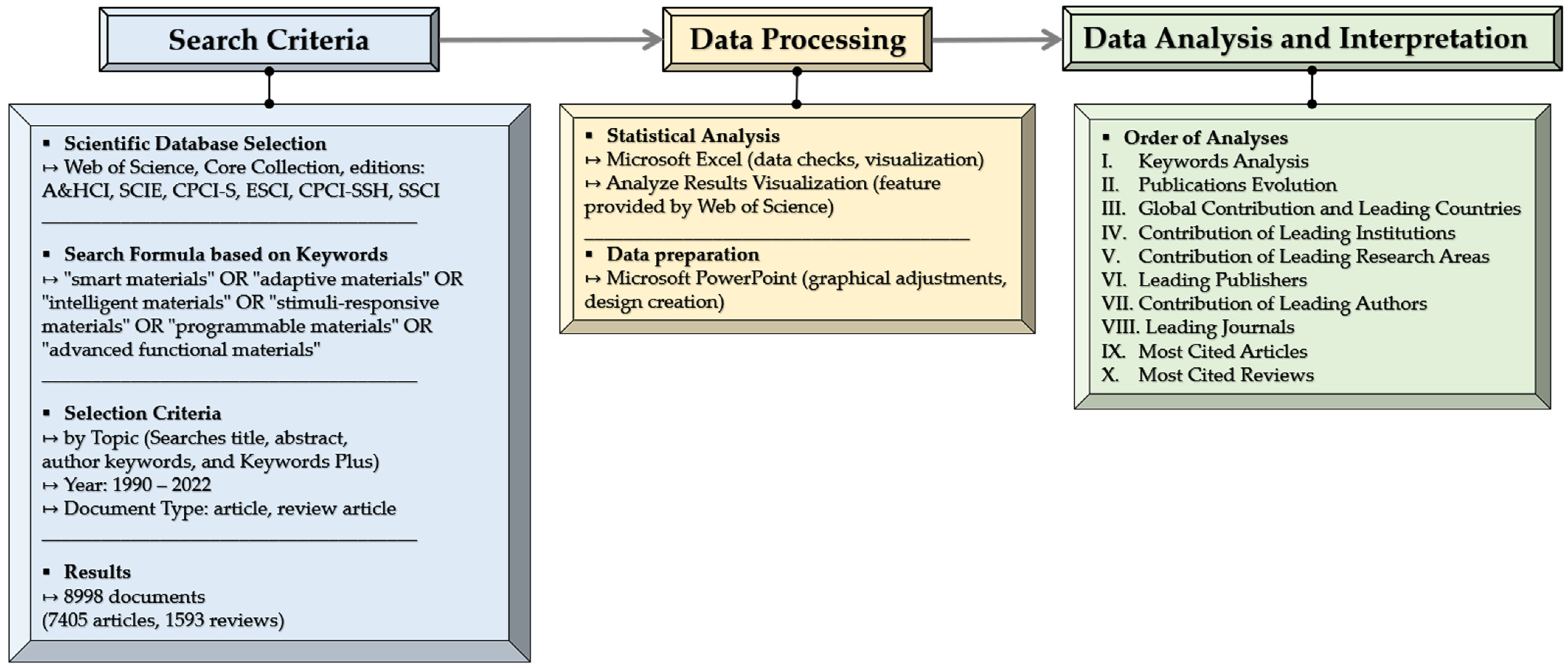
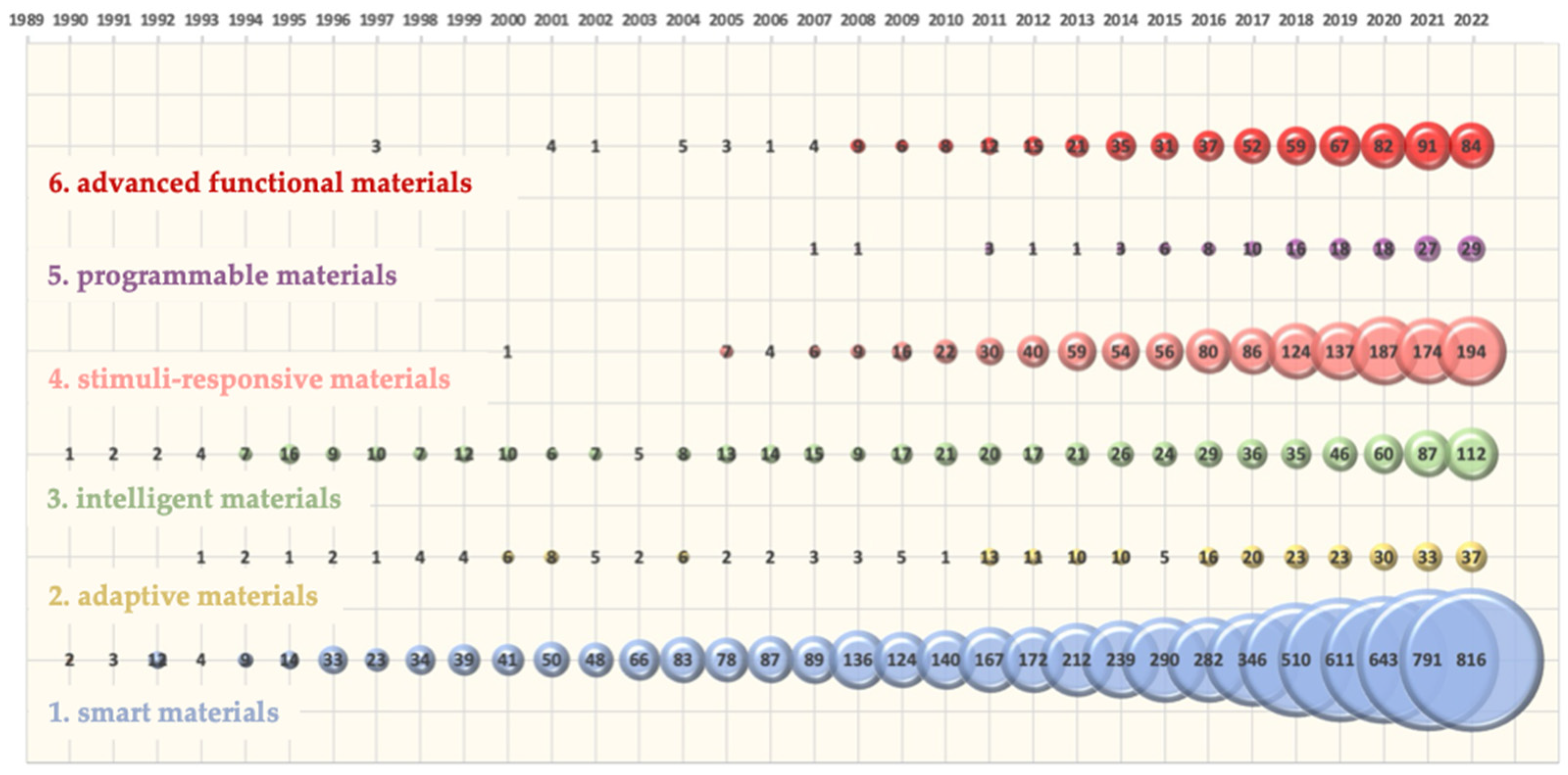
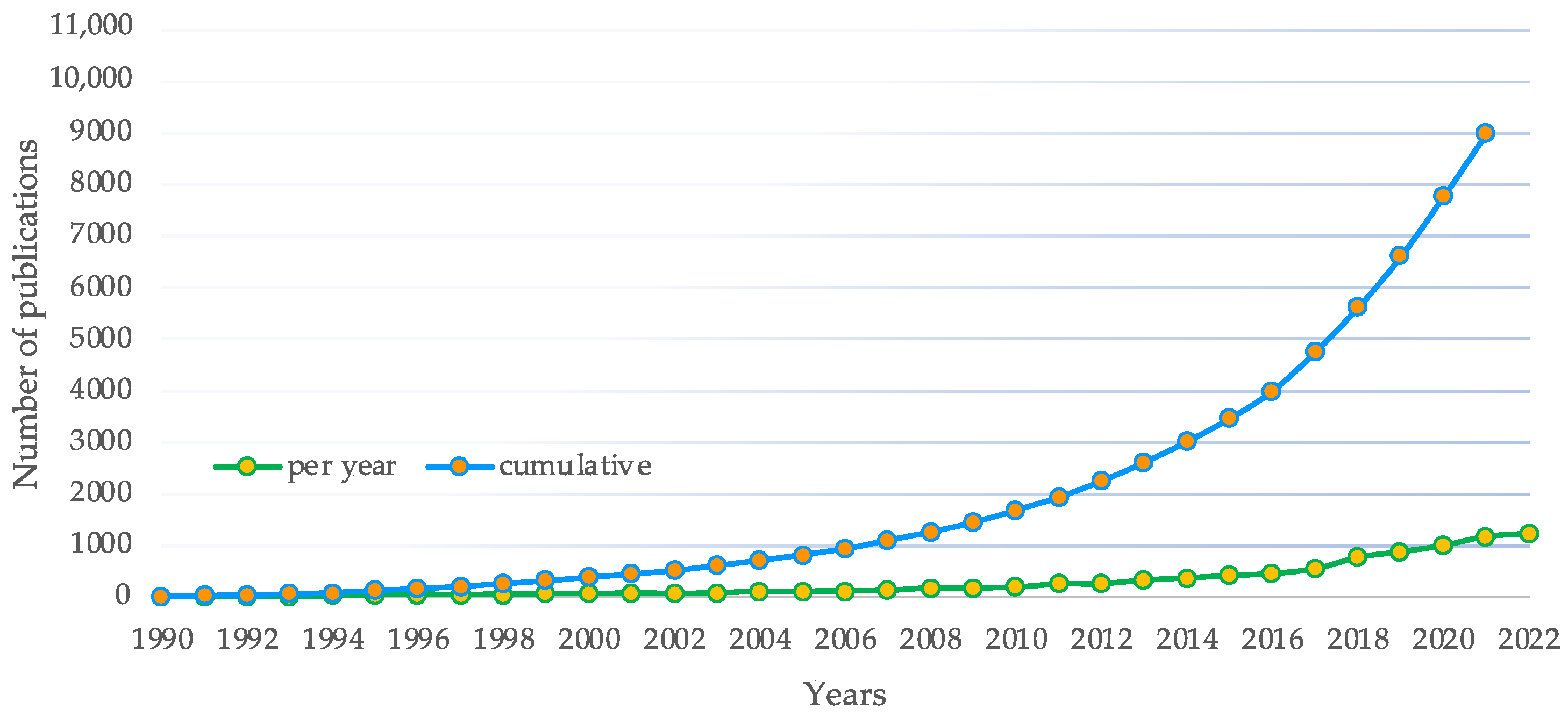
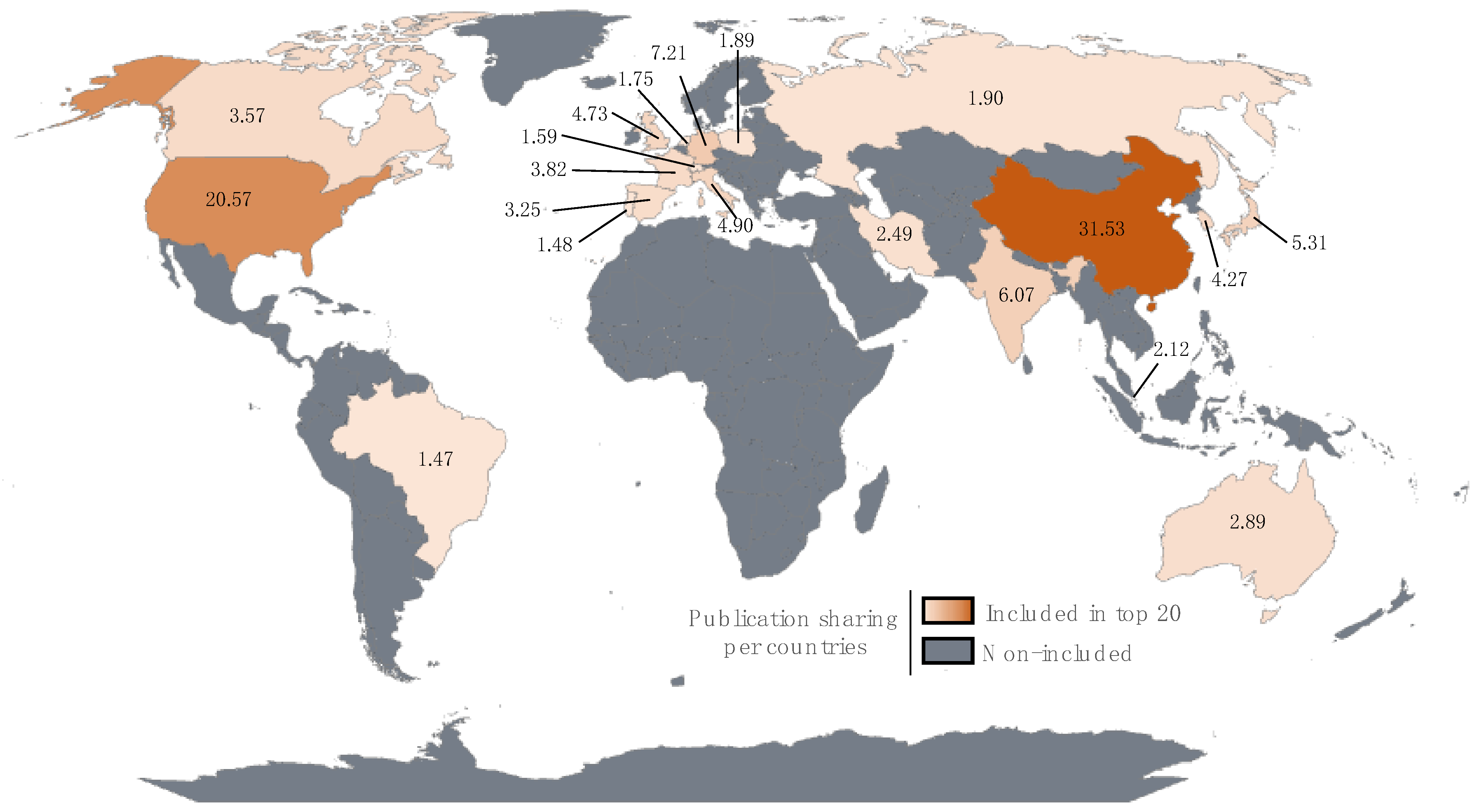
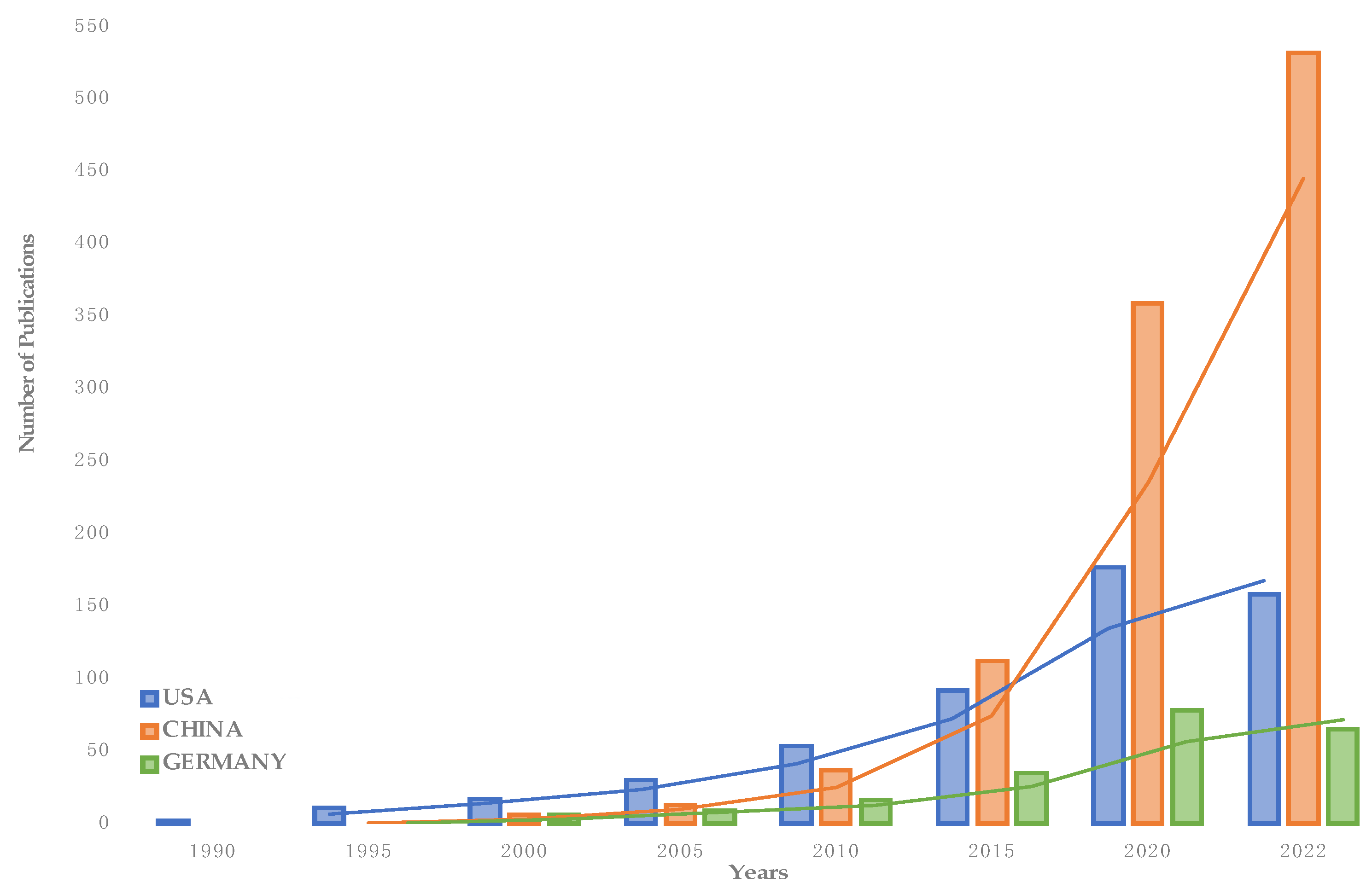
| Rank | Countries | TAc 1 | TC 2 | ACPP 3 |
|---|---|---|---|---|
| 1 | China | 2837 | 95,654 | 33.72 |
| 2 | USA | 1851 | 107,577 | 58.12 |
| 3 | Germany | 649 | 25,583 | 39.42 |
| 4 | India | 546 | 12,334 | 22.59 |
| 5 | Japan | 478 | 21,397 | 44.76 |
| 6 | Italy | 441 | 13,156 | 29.83 |
| 7 | United Kingdom | 426 | 22,027 | 51.71 |
| 8 | South Korea | 384 | 12,842 | 33.44 |
| 9 | France | 344 | 14,299 | 41.57 |
| 10 | Canada | 320 | 11,544 | 36.11 |
| 11 | Spain | 292 | 10,327 | 35.37 |
| 12 | Australia | 260 | 11,119 | 42.77 |
| 13 | Iran | 224 | 5302 | 23.67 |
| 14 | Singapore | 191 | 11,292 | 59.12 |
| 15 | Russia | 171 | 4241 | 24.8 |
| 16 | Poland | 170 | 2823 | 16.61 |
| 17 | Netherlands | 157 | 10,614 | 67.61 |
| 18 | Switzerland | 143 | 8063 | 56.38 |
| 19 | Portugal | 133 | 3550 | 26.69 |
| 20 | Brazil | 132 | 2930 | 22.2 |
| Rank | Institutions | TAi 1 | TAi/TAk 2 [%] | TC | ACPP | Country |
|---|---|---|---|---|---|---|
| 1 | Chinese Academy of Sciences | 392 | 4.357 | 18,030 | 45.93 | China |
| 2 | Centre National de la Recherche Scientifique | 217 | 2.412 | 9609 | 44.28 | France |
| 3 | Harbin Institute of Technology | 149 | 1.656 | 7362 | 49.941 | China |
| 4 | Indian Institute of Technology System | 147 | 1.634 | 2980 | 20.27 | India |
| 5 | Udice French Research Universities | 146 | 1.623 | 7496 | 51.34 | France |
| 6 | Tsinghua University | 129 | 1.434 | 6257 | 48.5 | China |
| 7 | University of California System | 123 | 1.367 | 8388 | 68.2 | United States |
| 8 | Sichuan University | 122 | 1.356 | 4382 | 35.92 | China |
| 9 | University System of Ohio | 107 | 1.189 | 5403 | 50.5 | United States |
| 10 | Swiss Federal Institutes of Technology | 103 | 1.145 | 5403 | 52.46 | Switzerland |
| 11 | University of Science Technology of China | 102 | 1.134 | 3378 | 33.12 | China |
| 12 | Zhejiang University | 102 | 1.134 | 6644 | 65.14 | China |
| 13 | Consiglio Nazionale Delle Ricerche | 101 | 1.122 | 3118 | 30.87 | Italy |
| 14 | Helmholtz Association | 101 | 1.122 | 3926 | 38.87 | Germany |
| 15 | University of Chinese Academy of Sciences | 100 | 1.111 | 3487 | 34.87 | China |
| 16 | Nanyang Technological University | 97 | 1.078 | 6851 | 70.63 | Singapore |
| 17 | Russian Academy of Sciences | 95 | 1.056 | 2284 | 24.04 | Russia |
| 18 | Shanghai Jiao Tong University | 93 | 1.034 | 2593 | 27.88 | China |
| 19 | Jilin University | 88 | 0.978 | 3047 | 34.63 | China |
| 20 | N8 Research Partnership | 85 | 0.945 | 4396 | 51.72 | United Kingdom |
| Rank | Research Area on WoS | TAra 1 | TAra/TAk [%] | TC | ACPP |
|---|---|---|---|---|---|
| 1 | Materials Science | 4412 | 49.033 | 172,254 | 39.04 |
| 2 | Chemistry | 2905 | 32.285 | 141,909 | 48.85 |
| 3 | Engineering | 1818 | 20.204 | 54,257 | 29.84 |
| 4 | Science Technology Other Topics | 1480 | 16.448 | 81,638 | 55.16 |
| 5 | Physics | 1477 | 16.415 | 66,301 | 44.89 |
| 6 | Polymer Science | 1121 | 12.458 | 38,383 | 34.24 |
| 7 | Instruments Instrumentation | 542 | 6.024 | 16,814 | 31.02 |
| 8 | Mechanics | 455 | 5.057 | 10,445 | 22.96 |
| 9 | Metallurgy Metallurgical Engineering | 232 | 2.578 | 5254 | 22.65 |
| 10 | Biochemistry Molecular Biology | 165 | 1.834 | 5556 | 33.67 |
| 11 | Energy Fuels | 133 | 1.478 | 6516 | 48.99 |
| 12 | Automation Control Systems | 131 | 1.456 | 4785 | 36.53 |
| 13 | Computer Science | 127 | 1.411 | 2483 | 19.55 |
| 14 | Optics | 113 | 1.256 | 2158 | 19.1 |
| 15 | Mathematics | 101 | 1.122 | 1720 | 17.03 |
| 16 | Pharmacology Pharmacy | 94 | 1.045 | 5656 | 60.17 |
| 17 | Electrochemistry | 92 | 1.022 | 2997 | 32.58 |
| 18 | Robotics | 81 | 0.900 | 2739 | 33.81 |
| 19 | Acoustics | 74 | 0.822 | 1252 | 16.92 |
| 20 | Biotechnology Applied Microbiology | 69 | 0.767 | 2550 | 36.96 |
| Rank | Publisher | TAp 1 | TAj/TAk [%] | TC | ACPP |
|---|---|---|---|---|---|
| 1 | Elsevier | 2348 | 26.095 | 93,821 | 39.96 |
| 2 | Wiley | 1369 | 15.214 | 67,568 | 49.36 |
| 3 | Amer Chemical Soc | 901 | 10.013 | 39,072 | 43.37 |
| 4 | Royal Soc Chemistry | 756 | 8.402 | 42,518 | 56.24 |
| 5 | Springer Nature | 596 | 6.624 | 25,866 | 43.4 |
| 6 | MDPI | 457 | 5.079 | 8694 | 19.02 |
| 7 | Iop Publishing Ltd. | 373 | 4.145 | 12,036 | 32.27 |
| 8 | Sage | 282 | 3.134 | 6458 | 22.9 |
| 9 | Taylor & Francis | 203 | 2.256 | 4349 | 21.42 |
| 10 | IEEE | 124 | 1.378 | 4340 | 35 |
| 11 | Science Press | 91 | 1.011 | 998 | 10.97 |
| 12 | Frontiers Media Sa | 72 | 0.800 | 1179 | 16.38 |
| 13 | ASME | 50 | 0.556 | 499 | 9.98 |
| 14 | Amer Inst Physics | 49 | 0.545 | 1493 | 30.47 |
| 15 | Nature Portfolio | 44 | 0.489 | 1820 | 41.36 |
| 16 | Chinese Acad Sciences | 41 | 0.456 | 221 | 5.39 |
| 17 | World Scientific | 39 | 0.433 | 541 | 13.87 |
| 18 | Techno-Press | 34 | 0.378 | 269 | 7.91 |
| 19 | Emerald Group Publishing | 30 | 0.333 | 654 | 21.8 |
| 20 | Trans Tech Publications Ltd. | 30 | 0.333 | 167 | 5.57 |
| Rank | Author | Country | TAa 1 | TC | ACPP | h-Index |
|---|---|---|---|---|---|---|
| 1 | Zhang Yu | China | 69 | 2985 | 43.26 | 24 |
| 2 | Liu Yu | China | 67 | 1969 | 29.39 | 26 |
| 3 | Leng Jinsong | China | 66 | 4775 | 72.35 | 30 |
| 4 | Wang Yong | USA | 61 | 1398 | 22.92 | 19 |
| 5 | Liu Yijun | China | 59 | 4658 | 78.95 | 30 |
| 6 | Lanceros-Mendez Senentxu | Spain | 57 | 1819 | 31.91 | 22 |
| 7 | Wang Li | China | 57 | 2897 | 50.82 | 27 |
| 8 | Wang Wen | China | 49 | 2491 | 50.84 | 24 |
| 9 | Wang Joseph | USA | 47 | 1524 | 32.43 | 24 |
| 10 | Zhang Jun | China | 44 | 960 | 21.82 | 19 |
| 11 | Zhang Lu | China | 44 | 1036 | 23.55 | 18 |
| 12 | Wang Hai | China | 41 | 1619 | 39.49 | 20 |
| 13 | Li Yi | China | 40 | 1614 | 40.35 | 20 |
| 14 | Li Jun | China | 37 | 874 | 23.62 | 18 |
| 15 | Li Li | China | 37 | 1065 | 28.76 | 18 |
| 16 | Chen Yu | China | 36 | 787 | 21.86 | 17 |
| 17 | Li Quan | China | 36 | 2142 | 59.5 | 20 |
| 18 | Kim Jungwook | USA | 35 | 2072 | 59.2 | 23 |
| 19 | Liu Jian | China | 33 | 893 | 27.06 | 16 |
| 20 | Zhang Qi | China | 33 | 964 | 29.21 | 17 |
| Rank | Journal | TAj 1 | TAj/TAk [%] | TC | JIF 2021 2 | JIF5 3 | JIF Quartile 4 |
|---|---|---|---|---|---|---|---|
| 1 | Composites Science and Technology | 238 | 2.645 | 11,852 | 9.788 | 8.788 | Q1 |
| 2 | ACS Applied Materials & Interfaces | 235 | 2.612 | 8824 | 10.383 | 10.382 | Q1 |
| 3 | Smart Materials and Structures | 230 | 2.556 | 6662 | 4.131 | 4.253 | Q2 |
| 4 | Composites Part B-Engineering | 214 | 2.378 | 8280 | 11.322 | 10.133 | Q1 |
| 5 | Journal of Intelligent Material Systems and Structures | 191 | 2.123 | 4968 | 2.774 | 2.734 | Q3 |
| 6 | Advanced Functional Materials | 179 | 1.989 | 11,470 | 19.924 | 19.978 | Q1 |
| 7 | Advanced Materials | 171 | 1.900 | 19,139 | 32.086 | 32.095 | Q1 |
| 8 | Angewandte Chemie International Edition | 132 | 1.467 | 10,421 | 16.823 | 15.311 | Q1 |
| 9 | Composites Part A Applied Science and Manufacturing | 118 | 1.311 | 4799 | 9.463 | 9.224 | Q1 |
| 10 | Polymers | 95 | 1.056 | 2562 | 4.967 | 5.063 | Q1 |
| 11 | Journal of Materials Chemistry C | 88 | 0.978 | 3415 | 8.067 | 7.642 | Q1 |
| 12 | Materials | 88 | 0.978 | 1391 | 3.748 | 4.042 | Q3 |
| 13 | Soft Matter | 80 | 0.889 | 3683 | 4.046 | 3.895 | Q2 |
| 14 | Journal of the American Chemical Society | 72 | 0.800 | 3974 | 16.383 | 16.289 | Q1 |
| 15 | Polymer | 69 | 0.767 | 1793 | 4.432 | 4.161 | Q1 |
| 16 | Polymer Chemistry | 67 | 0.745 | 2467 | 5.364 | 5.056 | Q1 |
| 17 | Macromolecular Rapid Communications | 66 | 0.733 | 2240 | 5.006 | 4.809 | Q1 |
| 18 | Chemistry A European Journal | 65 | 0.722 | 1954 | 5.02 | 4.822 | Q2 |
| 19 | RSC Advances | 65 | 0.722 | 1654 | 4.036 | 3.748 | Q2 |
| 20 | European Polymer Journal | 58 | 0.645 | 1301 | 5.546 | 5.006 | Q1 |
| R 1 | Title | Author | Journal | Year | Country | TC | Ref. |
|---|---|---|---|---|---|---|---|
| 1 | Polymerized colloidal crystal hydrogel films as intelligent chemical sensing materials | Holtz, JH and Asher, SA | Nature | 1997 | USA | 1745 | [30] |
| 2 | Nanostructured Tungsten Oxide—Properties, Synthesis, and Applications | Zheng, HD et al. | Advanced Functional Materials | 2011 | Australia | 1074 | [31] |
| 3 | Mechanically induced luminescence changes in molecular assemblies | Sagara, Y and Kato, T | Nature Chemistry | 2009 | Japan | 1012 | [32] |
| 4 | MR fluid, foam and elastomer devices | Carlson, JD, Jolly, MR, and | Mechatronics | 2000 | USA | 986 | - |
| 5 | A reversibly antigen-responsive hydrogel | Miyata, T; Asami, N and Uragami, T | Nature | 1999 | Japan | 945 | - |
| 6 | A model of the behavior of magnetorheological materials | Jolly, MR; Carlson, JD and Munzo, BC | Smart Materials & Structures | 1996 | USA | 682 | - |
| 7 | 4D Printing: multi-material shape change | Tibbits, S | Architectural Design | 2014 | USA | 673 | - |
| 8 | Mechanoresponsive Luminescent Molecular Assemblies: An Emerging Class of Materials | Sagara, Y et al. | Advanced Materials | 2016 | Japan | 663 | - |
| 9 | Synthesis, properties, and applications of graphene oxide/reduced graphene oxide and their nanocomposites | Simth, AT et al. | Nano Materials Science | 2019 | USA | 650 | - |
| 10 | Non-medical applications of shape memory alloys | Van Humbeeck, J | Materials Science and Engineering A-Structural Materials Properties Microstructure and Processing | 1999 | Belgium | 585 | - |
| 11 | Large-scale MR fluid dampers: modeling and dynamic performance considerations | Yang, G et al. | Engineering Structures | 2002 | USA | 575 | - |
| 12 | Rapid self-healing hydrogels | Phadke, A et al. | Proceedings of the National Academy of Sciences of the United States of America | 2012 | USA | 565 | - |
| 13 | Covalent Adaptable Networks (CANS): A Unique Paradigm in Cross-Linked Polymers | Kloxin, CJ et al. | Macromolecules | 2010 | USA | 553 | - |
| 14 | Nanofabricated media with negative permeability at visible frequencies | Grigorenko, AN et al. | Nature | 2005 | England | 539 | - |
| 15 | Advances in piezoelectric finite element modeling of adaptive structural elements: a survey | Benjeddou, A | Computers & Structures | 2000 | France | 529 | - |
| 16 | Recent advances in mechanochromic luminescent metal complexes | Zhang, XQ et al. | Journal of Materials Chemistry C | 2013 | China | 527 | - |
| 17 | A hallow fibre reinforced polymer composite encompassing self-healing and enhanced damage visibility | Pang, JWC and Bond, IP | Composites Science and Technology | 2005 | England | 518 | - |
| 18 | Fast-moving soft electronic fish | Li, TF et al. | Science Advances | 2017 | China | 509 | - |
| 19 | Formation of asymmetric one-sided metal-tipped semiconductor nanocrystal dots and rods | Mokari, T et al. | Nature Materials | 2005 | Israel | 475 | - |
| 20 | Cradle-to-cradle design: creating healthy emissions—a strategy for eco-effective product and system design | Braungart, M, McDonough, W, and Bollinger, A | Journal of Cleaner Production | 2007 | Germany | 472 | - |
| R | Title | Author | Journal | Year | Country | TC | Ref. |
|---|---|---|---|---|---|---|---|
| 1 | Mesoporous materials for drug delivery | Vallet-Regi, M, Balas, F, and Arcos, D | Angewandte Chemie- international edition | 2007 | Spain | 2096 | [33] |
| 2 | Visible-light driven heterojunction photocatalysts for water splitting—a critical review | Moniz, SJA et al. | Energy & Environmental Science | 2015 | England | 1736 | [34] |
| 3 | Stable metal-organic frameworks: design, synthesis, and applications | Yuan, S et al. | Advanced Materials | 2018 | USA | 1701 | [35] |
| 4 | Using the dynamic bond to access macroscopically responsive structurally dynamic polymers | Wojtecki, RJ et al. | Nature Materials | 2011 | USA | 1220 | - |
| 5 | Biomimetic super-lyophobic and super-lyophilic materials applied for oil/water separation: a new strategy beyond nature | Wang, B et al. | Chemical Society Reviews | 2015 | China | 1187 | - |
| 6 | Making molecular machines work | Browne, WR and Feringa, BL | Nature Nanotechnology | 2006 | Netherlands | 1145 | - |
| 7 | Future perspectives and recent advances in stimuli-responsive materials | Roy, D, Camber, JN, and Sumerlin, BS | Progress in Polymer Science | 2010 | USA | 1132 | - |
| 8 | Flexible nanodielectric materials with high permittivity for power energy Storage | Dang, ZM et al. | Advanced Materials | 2013 | China | 1086 | - |
| 9 | Shape-memory polymers and their composites: stimulus methods and applications | Leng, JS et al. | Progress in Materials Science | 2011 | China | 1079 | - |
| 10 | Nanostructured functional materials prepared by atom transfer radical polymerization | Matyjaszewski, K and Tsarevsky, NV | Nature Chemistry | 2009 | USA | 1039 | - |
| 11 | Growth factor delivery-based tissue engineering: general approaches and a review of recent developments | Lee, K, Silva, EA, and Mooney, DJ | Journal of the Royal Society Interface | 2011 | USA | 975 | - |
| 12 | Programmable materials and the nature of the DNA bond | Jones, MR, Seeman, NC, and Mirkin, CA | Science | 2015 | USA | 964 | - |
| 13 | New directions in thermoresponsive polymers | Roy, D, Brooks, WLA, and Sumerlin, BS | Chemical Society Reviews | 2013 | USA | 956 | - |
| 14 | Recent advances in shape-memory polymers: structure, mechanism, functionality, modeling and applications | Hu, JL et al. | Progress in Polymer Science | 2012 | China | 939 | - |
| 15 | Recent progress in shape memory polymer: New behavior, enabling materials, and mechanistic understanding | Zhao, Q, Qi, HJ, and Xie, T | Progress in Polymer Science | 2015 | China | 927 | - |
| 16 | Bioresponsive materials | Lu, Y et al. | Nature Reviews Materials | 2017 | USA | 884 | - |
| 17 | Functional soft materials from metallopolymers and metallosupramolecular polymers | Whittell, GR et al. | Nature Materials | 2011 | England | 828 | - |
| 18 | Thermoresponsive Polymers for Biomedical Applications | Ward, MA and Georgiou, TK | Polymers | 2011 | England | 806 | - |
| 19 | Prussian Blue and its analogues: Electrochemistry and analytical applications | Karyakin, AA | Electroanalysis | 2001 | Russia | 794 | - |
| 20 | Magnetorheological fluids: a review | de Vicente, J, Klingenberg, DJ, and Hidalgo-Alvarez, R | Soft Matter | 2011 | Spain | 762 | - |
Disclaimer/Publisher’s Note: The statements, opinions and data contained in all publications are solely those of the individual author(s) and contributor(s) and not of MDPI and/or the editor(s). MDPI and/or the editor(s) disclaim responsibility for any injury to people or property resulting from any ideas, methods, instructions or products referred to in the content. |
© 2023 by the authors. Licensee MDPI, Basel, Switzerland. This article is an open access article distributed under the terms and conditions of the Creative Commons Attribution (CC BY) license (https://creativecommons.org/licenses/by/4.0/).
Share and Cite
Petrașcu, R.M.; Racz, S.-G.; Rusu, D.-M. Mapping Smart Materials’ Literature: An Insight between 1990 and 2022. Sustainability 2023, 15, 15143. https://doi.org/10.3390/su152015143
Petrașcu RM, Racz S-G, Rusu D-M. Mapping Smart Materials’ Literature: An Insight between 1990 and 2022. Sustainability. 2023; 15(20):15143. https://doi.org/10.3390/su152015143
Chicago/Turabian StylePetrașcu, Raul Mihai, Sever-Gabriel Racz, and Dan-Mihai Rusu. 2023. "Mapping Smart Materials’ Literature: An Insight between 1990 and 2022" Sustainability 15, no. 20: 15143. https://doi.org/10.3390/su152015143
APA StylePetrașcu, R. M., Racz, S.-G., & Rusu, D.-M. (2023). Mapping Smart Materials’ Literature: An Insight between 1990 and 2022. Sustainability, 15(20), 15143. https://doi.org/10.3390/su152015143








